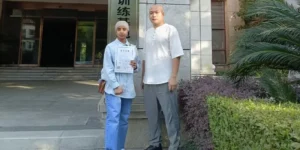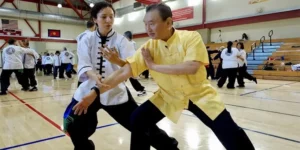China is the birthplace of martial arts, boasting numerous martial arts schools ranging from temple training grounds to private martial arts academies.
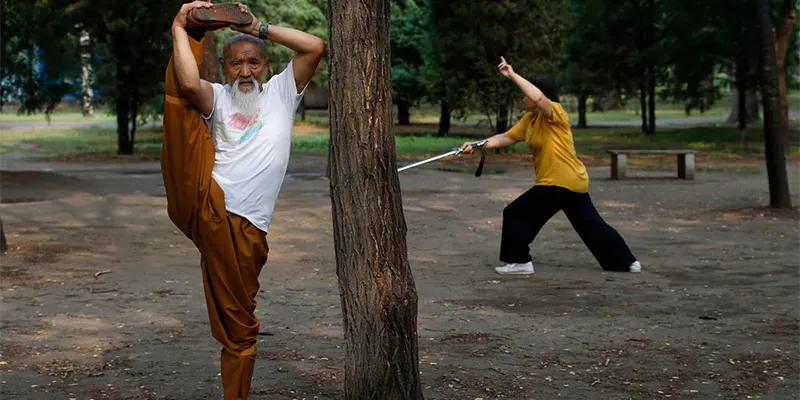
This guide comprehensively sums up China’s most important and prestigious martial arts schools and institutions, focusing on the two pillars of Chinese martial arts: external styles (Shaolin Temple) and internal styles (Wudang Mountain and Tai Chi).
Study Martial Arts’ Three Pillars
The two most significant historical and cultural centers for martial arts study are Mount Song’s Shaolin Temple (external martial art) and Mount Wudang (internal martial art). The third equally important destination is Chenjiagou, the birthplace of Tai Chi.
External Martial Arts: Shaolin
Located in the Songshan Mountains of Henan Province, the Shaolin Temple is world-renowned as the birthplace of Zen Buddhism and Shaolin Kung Fu. Training here demands total commitment to highly disciplined, physically demanding practices emphasizing strength, speed, agility, and form sequences.
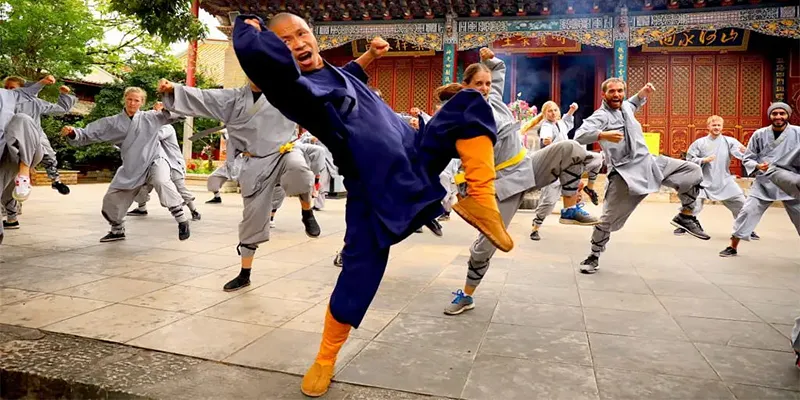
Dengfeng City and Songshan Mountain
Dengfeng City’s Shaolin Temple serves as the epicenter of Kung Fu. The monastery itself primarily focuses on training martial monks and cultural exchange, while numerous large affiliated martial arts academies provide training for international students.
Shaolin Pagoda Valley Martial Arts School:
Focus: Traditional Shaolin Kung Fu, Sanda (Chinese kickboxing), and various traditional weaponry.
Features: Hailed as the world’s largest and most comprehensive martial arts academy, it is often dubbed the “Shaolin Harvard” due to its massive scale (enrolling tens of thousands of students). It offers highly disciplined, large-scale, and extremely rigorous training. The school boasts high-level martial arts masters, many of whom are national-level coaches, providing a structured training environment.
Choose for serious, long-term students and those seeking complete immersion in a high-intensity, competitive, professional Chinese martial arts atmosphere.
Dengfeng Epo Martial Arts School:
Focus: Authentic Shaolin Kung Fu curriculum and forms.
Features: Kunyu Mountain Shaolin Kung Fu Academy: A large-scale institution with an excellent reputation, it is highly regarded for offering high-quality, authentic Shaolin martial arts training at relatively affordable prices compared to other major martial arts centers. The academy strictly adheres to traditional training schedules.
Kunyu Mountain Shaolin Kung Fu Academy:
Location: Situated on Kunyu Mountain in Shandong Province, away from the bustle of Dengfeng city.
Features: Employs a holistic teaching approach integrating traditional Shaolin forms with internal styles and practical self-defense techniques.
Choose for: Students seeking authentic Shaolin instruction from masters in a tranquil, spiritually enriching mountain setting with minimal commercial influence.
Internal Martial Arts: Wudang and Tai Chi
While Shaolin focuses on the waigong external effort, the Wudang Mountains and the Chenjiagou village represent the pinnacle of internal effort, emphasizing Qi, mind-body connection, and soft, fluid movements.

Wudang Mountain
Located in Hubei province, Wudang is the spiritual home of Daoist martial arts and is often credited as the birthplace of Tai Chi Chuan (Taijiquan), though historical records also point to the Chen village. Studying here means focusing on the Internal Family styles.
Wudang Daoist Kung Fu Academy:
Focus: Wudang Kung Fu, Tai Chi, Baguazhang, Xingyiquan, Qigong, and traditional Daoist health practices.
Notability: Schools in this area are run by authentic Daoist masters and offer a blend of martial training, meditation, and Daoist philosophy. The training is often more personalized and less focused on large-scale performance than the Shaolin academies.
Ideal For: Practitioners interested in the spiritual, health-focused, and philosophical dimensions of martial arts, particularly those seeking to master Tai Chi, Qigong, and the foundational internal arts. The setting in the sacred Wudang mountains provides an unparalleled atmosphere for self-cultivation (xiu lian).
Wudang Gong Fu and Health Academy:
Features: Smaller, more traditional schools often focus on a direct master-to-disciple relationship. These intimate settings allow for training plans tailored to the individual’s body condition and specific goals, which is crucial for the subtle art of internal arts.
Chenjiagou Village
Located in Wen County, Henan Province, this small village is the undisputed birthplace of the Chen Style Tai Chi, the oldest of the five main family styles.
Chenjiagou Tai Chi School / Chen Family Academies:
Focus: Pure, authentic Chen Style Tai Chi, including the Laojia (Old Frame), Xinjia (New Frame), and Er Lu (Cannon Fist), along with Tui Shou (Push Hands) and weapons.
Features: Studying here places you directly in the village where the art originated over 300 years ago. You will learn directly from the lineal descendants and most renowned masters of the Chen family.
Choose For: Anyone seeking the absolute, uncompromised source of Tai Chi Chuan, especially serious Tai Chi practitioners looking for deep instruction on internal chan si jing and combat application.
Other Martial Art Styles
While the “Big Three” dominate the landscape, China has other styles.
| Martial Arts Style | Premier Location/School Type | Noteworthy Features |
| Baji Quan | Mengcun Hui Autonomous County, Hebei | The historical and primary center for this powerful, explosive style. Look for schools within the Wu family lineage. Training is renowned for its short-range combat power. |
| Wing Chun | Foshan, Guangdong | While often studied in Hong Kong, Foshan is the ancestral home of Wing Chun Grandmaster Ip Man. Look for traditional Guan (Kung Fu Halls) teaching the various lineages of the style. |
| Traditional Wushu (Sanda/Modern Wushu) | Provincial Sports Universities | Institutions like the Beijing Sport University or Shanghai University of Sport offer high-level, academic, and competitive training in Sanda (Chinese kickboxing) and modern Wushu forms. |
Study Martial Arts Professional Guide
Choosing where to study martial arts is not merely about location; it’s about matching your goals to the school’s reality.
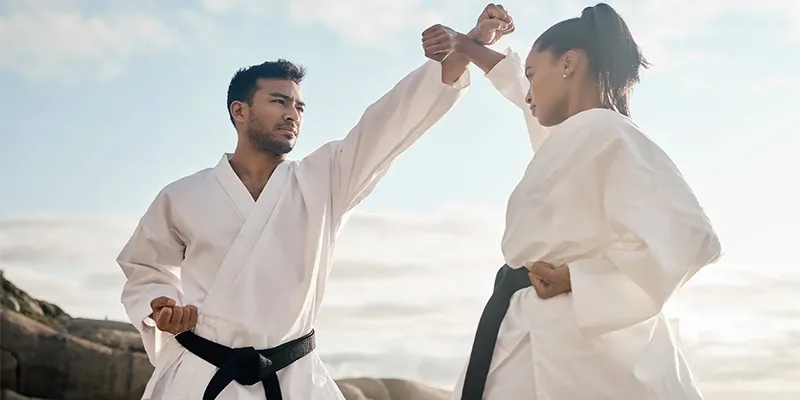
Defining Your Goal: External vs. Internal
If you seek explosive power, hard conditioning, dynamic forms, and competitive fighting, Shaolin and its large academies are your primary choice. Be prepared for a very demanding, often military-like schedule and large class sizes.
If you seek mind-body balance, energy cultivation, soft power, health, and slow-form mastery, Wudang or Chenjiagou are the appropriate destinations. The wushu pace is generally slower and more focused on internal martial arts, and the environment is often more peaceful.
Verifying Its Authenticity
In modern life, many commercial schools cater to tourists. For a serious, professional experience, look for schools that:
Are run by direct, recognized lineage holders: For Tai Chi, is the master a certified Chen family successor? For Wudang, is the master a recognized Daoist priest/disciple of an official lineage (e.g., Xuanwu Pai)?
Emphasize fundamental training: The best schools prioritize jiben gong over quick wushu forms. Be wary of programs promising multiple complex forms in a short period.
Offer a full cultural immersion: Look for schools that include supplementary classes in Chan/Daoist philosophy, Mandarin Chinese, calligraphy, or traditional Chinese medicine (TCM) to enrich your understanding.
The Reality of the Training Environment
Studying martial arts in China is an intensive, rigorous experience, often far from luxurious.
Accommodation: Expect simple, functional dormitory-style living. Single rooms may be available but are more expensive.
Schedule: A typical day starts with sunrise training (5:30 AM – 6:00 AM) and includes 6-8 hours of dedicated practice, six days a week, regardless of weather.
The Masters: Authentic masters are highly respected and expect discipline, respect, and tireless effort. The master-disciple relationship (Shifu) is central to the learning process.
FAQs
How to Study Martial Arts at Home?
To study martial arts at home, one must dedicate the majority of time to fundamental skills, which include intense physical conditioning and holding foundational stances for prolonged periods to build strength.
Looking for high-quality books or videos from recognized masters to learn forms and techniques, engaging in meticulous shadow boxing to develop muscle memory, visualization, and coordination.
Did Jackie Chan Study Martial Arts?
Yes, Jackie Chan is unequivocally a highly trained martial artist whose legendary on-screen style is the direct result of a decade of rigorous training at the China Drama Academy in Hong Kong.
From the age of seven, he endured an intense, disciplined curriculum that focused heavily on acrobatics, Wushu (martial arts), and dramatic performance, providing him with a spectacular foundation in flexibility, speed, and body control that is evident in every stunt.
Beyond his opera training, Chan furthered his martial education by studying specific styles, notably earning a black belt in the Korean art of Hapkido and practicing various forms of traditional Chinese Kung Fu.
Why Study Martial Arts?
The decision to study martial arts over simple self-defense.
Physically, it provides a superior, full-body workout that enhances cardiovascular health, builds functional strength, improves flexibility, and develops motor coordination that transfers to general life.
Mentally, study martial arts cultivates intense focus, patience, and mental fortitude, fostering a quiet confidence.
Philosophically, traditional arts like Tai Chi and Kung Fu teach that true mastery lies not in physical confrontation but in self-control and the ability to responsibly manage one’s own power.

